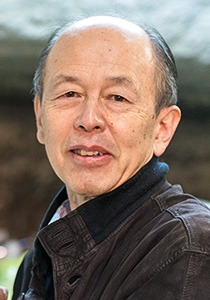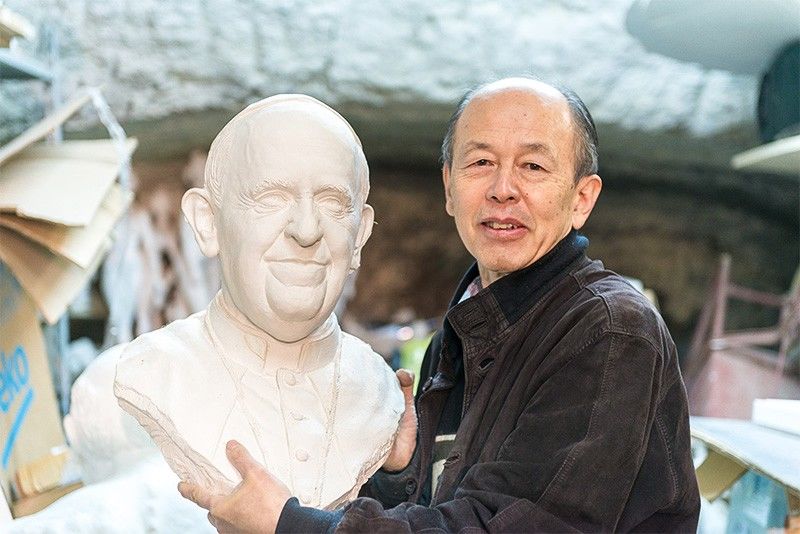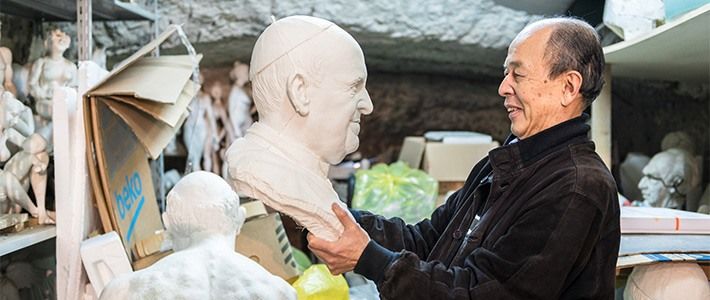
Sculpting the Subject's Innate Qualities
Culture- English
- 日本語
- 简体字
- 繁體字
- Français
- Español
- العربية
- Русский
In Bracciano, a town northwest of Rome, sculptor Okumura Nobuyuki is hard at work in his studio, a space converted from a grotto by ancient Etruscans. Okumura has taken up the ancient Italian method of casting molds, a technique that has been largely abandoned by contemporary Italian sculptors due to the cumbersome processes it involves. Okumura first rose to prominence back in 2003 for his work on a bust of Pope John Paul II. The sculpture, which gained him attention and praise for his subtle touch and excellent technique, now sits in the Barberini Room of the Vatican Library.
Introduction to the Vatican
INTERVIEWER What’s it like to be involved with classical styles of Italian sculpture in Italy?
OKUMURA NOBUYUKI Well, never in my wildest dreams did I imagine that I, neither Catholic nor Italian, would produce something like a bust of a pope.
The Barberini Room where my statue of John Paul II [1920–2005] now resides was designed by the highly influential Gian Lorenzo Bernini [1598–1680], a man who has been called the father of Baroque sculpture. What was more surprising, the sculpture that sits facing mine, a bust of Pope Urban VIII [1568–1644], was created by Bernini himself.
When I look at these two statues facing each other and think of the four centuries that separate them, something tells me that Bernini would be impressed at what I accomplished. Italian sculptors may be renowned for their dynamism when it comes to creating molds, but I believe that the Japanese are exceptionally gifted when it comes to capturing minute details through sculpture.
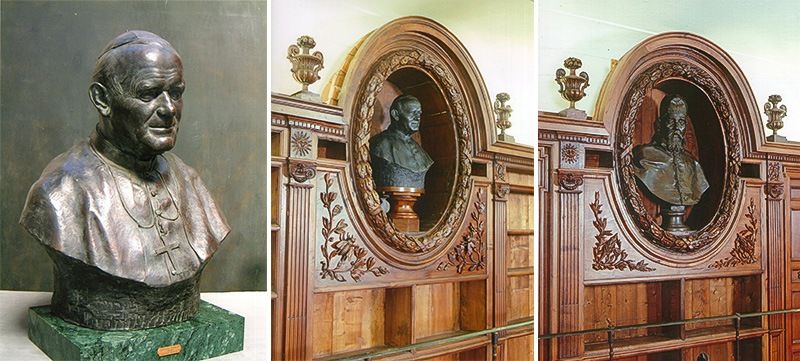 Okumura’s bust of Pope John Paul II (left), standing around 75 centimeters tall (© Okumura Nobuyuki). The statue, shown in the center, sits inside the Barberini Room of the Vatican Library across from a bust of Pope Urban VIII, at right, created by Bernini. (© Vatican City State)
Okumura’s bust of Pope John Paul II (left), standing around 75 centimeters tall (© Okumura Nobuyuki). The statue, shown in the center, sits inside the Barberini Room of the Vatican Library across from a bust of Pope Urban VIII, at right, created by Bernini. (© Vatican City State)
As for how I started sculpting busts of popes, much of it simply has to do with good fortune. In 1995, I sculpted a portrait statue for a family of nobles living here in Bracciano. During a party to commemorate its unveiling, I happened to meet a married couple who were descendants of the Borgheses, a family that itself provided a pope in the past. Princess Niké Arrighi Borghese said she would love for me to craft a sculpture of her husband, Prince Paolo Borghese, so I paid several visits to the Palazzo Borghese in Artena, southwestern Rome, that they call home.
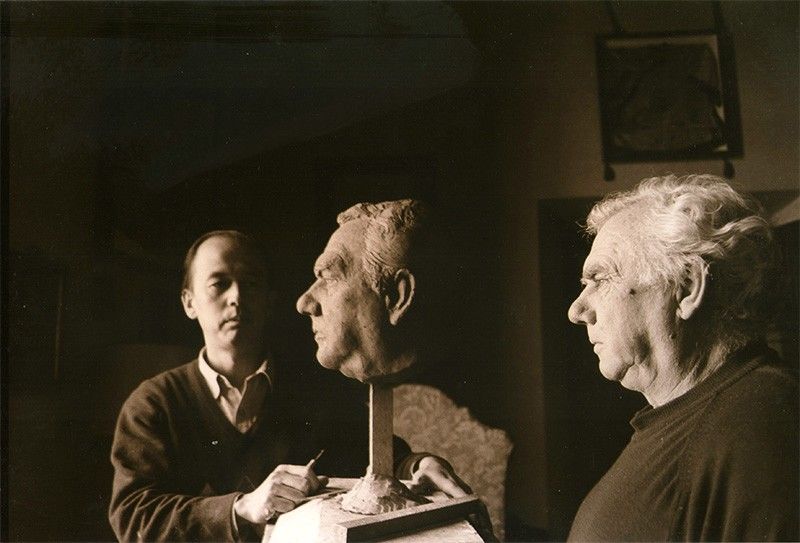 Okumura makes a clay model for the bronze statue of Prince Paolo Borghese. (© Okumura Nobuyuki)
Okumura makes a clay model for the bronze statue of Prince Paolo Borghese. (© Okumura Nobuyuki)
During those visits, I would get a feel for Prince Paolo’s countenance, observing his expressions and bone structure. When the bronze statue was completed, the Borgheses were so happy with the result that they started mentioning me to their friends and acquaintances. This is how I met the Grand Master of the Order of Malta in Rome, Franz von Lobstein, who introduced me to members of the Vatican.
INTERVIEWER Did this lead right away to the commission of your bust of the pope?
OKUMURA Surprisingly, yes, it did. Von Lobstein was interested in having me create not just a sculpture of himself but of then Pope John Paul II. At first I was incredulous, but I sculpted a rough model out of clay and gave von Lobstein a photo of the model that would be used to create the bronze statue. Soon after this, I received word from the pope’s right-hand man, Cardinal Pio Laghi. He said that he would arrange for me to meet His Holiness at a celebration of the twenty-fifth anniversary of John Paul II’s pontificate and that I should get to work on creating the bronze statue right away. For the next six months I worked tirelessly to finish the statue.
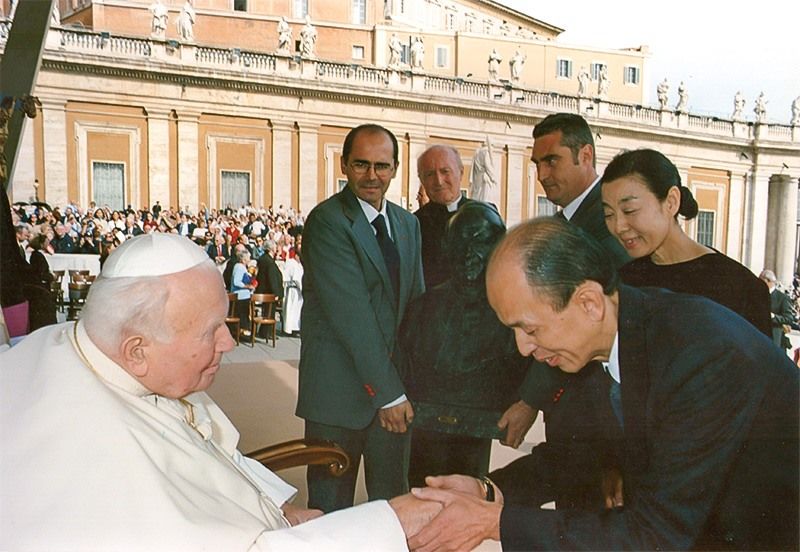 Pope John Paul II thanks Okumura during a celebration held on October 16, 2003, to mark the twenty-fifth anniversary of his pontificate. (© Vatican City State)
Pope John Paul II thanks Okumura during a celebration held on October 16, 2003, to mark the twenty-fifth anniversary of his pontificate. (© Vatican City State)
Typically, when I create a sculpture of someone, I meet with the person as many times as possible and speak with him or her to try and find inspiration that I’ll later call on during the sculpting process. However, this wasn’t feasible with the pope, so I instead researched his contributions to Catholicism and society while I created the sculpture using photographs of the man.
In Pursuit of Realism
INTERVIEWER When Pope John Paul II saw the bust that you sculpted, he took your hand and thanked you over and over. How did it feel to have your work welcomed so warmly?
OKUMURA Bronze statues are works of art that will last thousands of years. When I met John Paul II, he was in his eighties. His Parkinson’s disease had started to take a turn for the worse. His face was swollen, but the man still maintained an air of majesty. I devoted my time to molding a face that preserved the dignity and virility of a man who had travelled the world, working to help others, well into his sixties.
I attempted to create a bust where the subject’s age would not be readily apparent, one that housed all that comes to mind when one thinks of the pope. By daring to make the veins more pronounced, I was able to produce an image of the man in his prime, full of youthful vigor. At the same time, by making the contours of his countenance more rounded I could express the kind of man he was, a personality shaped over time. In other words, I combined within the piece images of him in both his sixties and his eighties.
INTERVIEWER You must have felt as though your efforts had finally been rewarded—your dedication to the lessons of your teacher, the sculptor Emilio Greco, to strive for such realistic quality that viewers might believe blood actually coursed through veins in your pieces.
OKUMURA Whether you’re creating a novel, picture, or sculpture, creativity is required to enhance its reality. Using computer graphics or a 3D printer lets you only capture the physical qualities of the subject at a certain point in time. However, this amounts to nothing more than a mere imitation of the subject, which differs vastly from the work of artists in pursuit of realism. It is precisely because the true qualities of the subject are captured, and that their emotions and expressions are kneaded into the work, that it achieves a kind of human warmth in its final form. This allows the artist to afford the work with a kind of universal appeal. It was my esteemed teacher, Greco, who first made me aware of this fact.
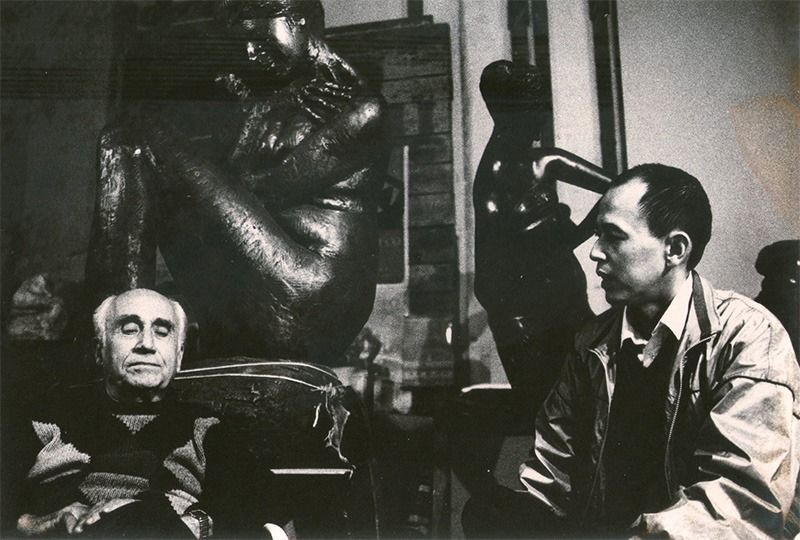 Greco (left) and Okumura chat in the former’s Rome studio. (© Okumura Nobuyuki)
Greco (left) and Okumura chat in the former’s Rome studio. (© Okumura Nobuyuki)
INTERVIEWER In 1975, your took a leave of absence from your sculpture studies at Tokyo Gakugei University and matriculated at the Academy of Art, Rome. This was when you first studied under Greco, but it wasn’t until 1990 that you began your apprenticeship with him.
OKUMURA After I finished my studies in Rome, I returned to Japan and graduated from university. For the next ten years after graduation, I took on different jobs, like helping to create sets for the Godzilla films and teaching art. However, I still couldn’t give up my first love of sculpture, so I set out back for Rome with my wife.
The next year we gave birth to our daughter. There were lots of jobs coming in from Japan, so things were going well. But as soon as the economic bubble burst in the late 1980s, much of my income went with it. Still, the thought of returning to Japan never once crossed my mind. Swimming in the huge lake in front of our home with my daughter, seeing the vestiges of medieval Italy in the neighborhood, all these things served as a wellspring of creativity for me. I couldn’t give them up.
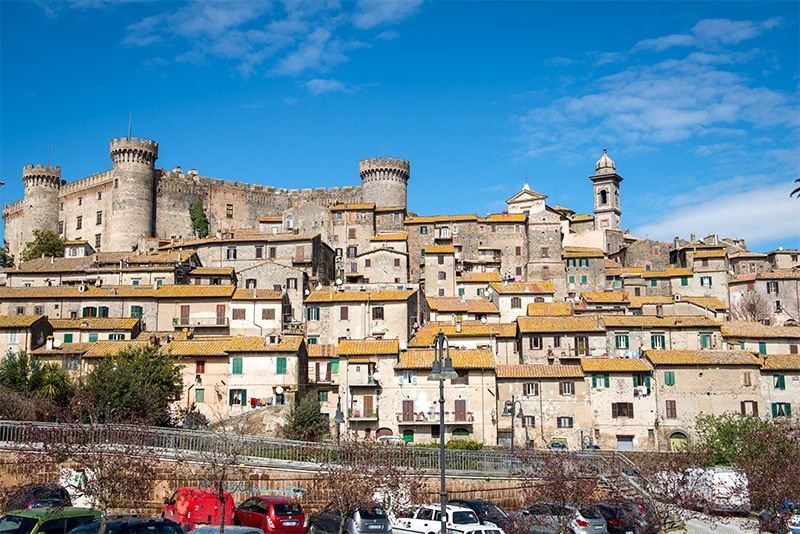 The medieval town of Bracciano, about 30 kilometers northwest of Rome. Okumura’s studio is located nearby.
The medieval town of Bracciano, about 30 kilometers northwest of Rome. Okumura’s studio is located nearby.
Into 1990, I knocked on the door of Greco’s workshop and introduced myself as “a former student of yours from the Academy.” He said that he remembered me well, looked at my portfolio, and told me that I excel in realism. I later learned that he would tell any student that visited him, “I remember you well,” but it was these words that drove me to pursue my career as a realist sculptor. The advice he gave me from that day until his death five years later is something that I will cherish forever.
Preserving Ancient Sculpting Traditions
INTERVIEWER You pride yourself on your adherence to 3,000-year-old sculpting techniques known as lost-wax casting.
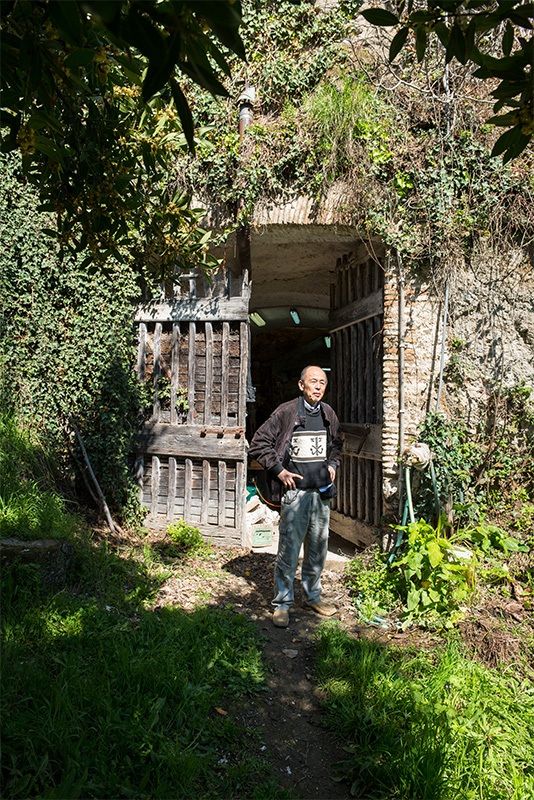 Okumura at the entrance to his studio.
Okumura at the entrance to his studio.
OKUMURA Nowadays the number of Italian sculptors that use this laborious, time-consuming process to create large-scale works has decreased. There simply just aren’t the necessary artisans for casting that there once were.
In lost-wax casting, I first make a model out of clay, which I then use to create a mold out of silicon. There’s only one place left in Rome with a specialized artisan who can make these silicon molds, though. After the silicon mold is made, it is again re-created in plaster, making it even harder. When it comes to procedures such as pouring the wax into the silicon mold, waiting for it to harden, then melting away portions of the wax and pouring in the bronze itself, foundries able to undertake such works no longer exist in Rome, so I have to travel to Florence.
This all sounds like a huge pain, but other casting methods just don’t provide the same kind of precision or casting surface that I prefer. For me, the Italian lost-wax method is the perfect means, as it allows me to reproduce subtle human emotions and physical features like individual hairs and wrinkles.
During the process of creating the wax mold, the step before finally pouring the bronze, I thoroughly check everything in minute detail and sometimes recarve things as needed. I make the final check with my own two eyes and then sign off on the wax mold. As opposed to a mold that will be used over and over again to create multiple works, this mold will be used to produce a truly original, one-of-a-kind piece.
With this method, you’ll never be able to reproduce the same piece twice. There are all sorts of minute differences at play: the kind of plaster for sculpting; the temperature of the kiln when melting off the wax; the composition and mixture of the bronze and the temperature at which it’s melted together. You simply have to give yourself over to chance, like a potter does when putting a work into the kiln. That said, I still work to imbue my own individuality in the pieces by mixing the different metals to create my own bronze.
Also, once the piece has been cast, I don’t polish or paint the surface of the sculpture like most others do. I prefer to preserve the beauty of the casted metal itself, to preserve that natural quality in the work. Using this kind of process lets the piece take on new characteristics as time passes, and I enjoy seeing that transformation in my work. It’s for these reasons that I feel so passionately about preserving the traditional Greco-Roman sculpting and casting method.
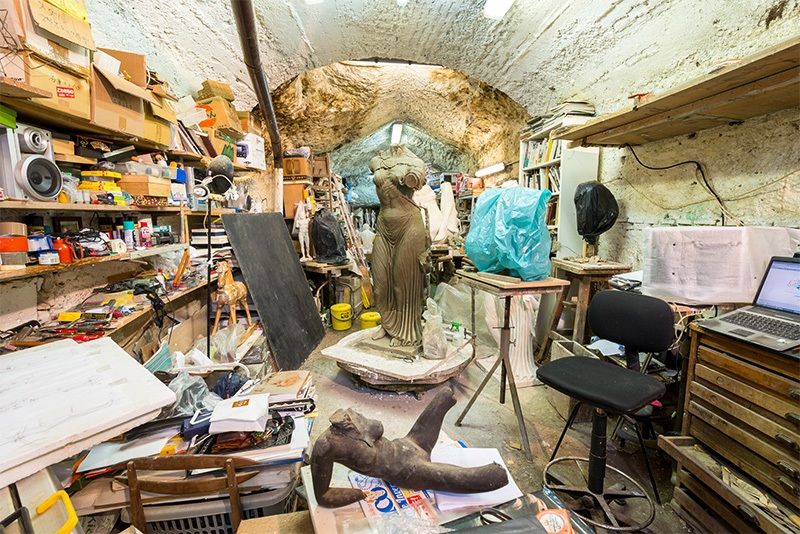 Okumura’s studio, built in a converted grotto. The artist says this kind of atmosphere is ideal for a sculptor as the job is rough.
Okumura’s studio, built in a converted grotto. The artist says this kind of atmosphere is ideal for a sculptor as the job is rough.
Bringing Together East and West Through Sculpture
INTERVIEWER Your works can be placed in four main categories: human portraits, such as the one of Pope John Paul II; sculptures of things in motion, like horses; those utilizing motifs from Greek mythology; and Buddhist images containing elements of Japanese aesthetics.
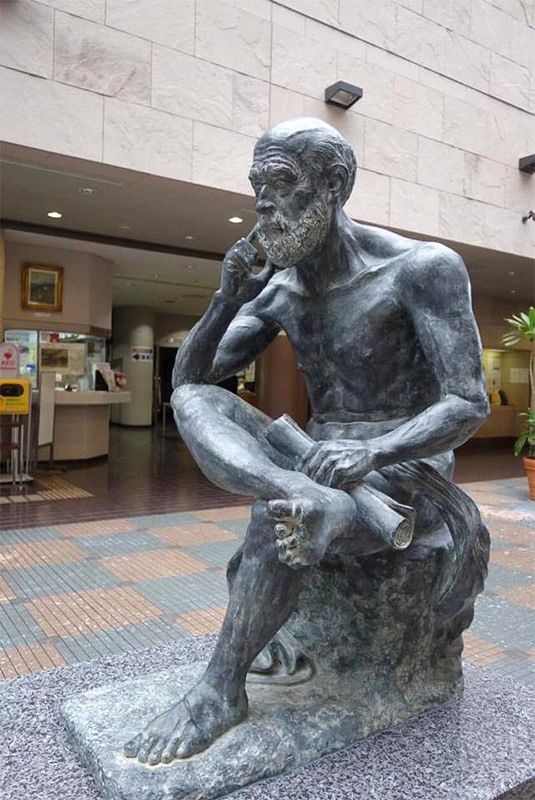 Thinking Hippocrates, housed at the Cosmate Yukuhashi cultural facility in Yukuhashi, Fukuoka. (© Okumura Nobuyuki)
Thinking Hippocrates, housed at the Cosmate Yukuhashi cultural facility in Yukuhashi, Fukuoka. (© Okumura Nobuyuki)
OKUMURA While many in the art world may lionize abstract sculptures or pop art and the like, I want to focus my attention on traditional bronze sculptures. Moreover, I want to produce the kinds of works that don’t simply just represent the outward appearance of the subject, but are also regarded as capturing its spirit or internal qualities. I think this is where I can demonstrate my strength the most. Recently orders from Japan have been increasing rapidly.
My statue Thinking Hippocrates, which won the grand prize at the 2017 Yukuhashi International Figurative Sculpture Competition, is now on display in the city of Yukuhashi, Fukuoka, at a culture complex. The sculpture features the titular physician of ancient Greece sitting with his right leg atop his left and his right arm pressed against his cheek in a pose reminiscent of a contemplative Bodhisattva. It has been praised for presenting a universality that transcends both Eastern and Western civilizations in a single work.
While I’m very grateful for such high remarks, my creative philosophy of fusing Eastern and Western cultures is to blend the dynamic compositions of Western sculpture and the refined sensibilities of their Eastern counterparts. In other words, I’d like to display the robust design skills that I’ve learned in Rome for more than thirty years, combining them with the subtle sensitivity that Japanese creators have handed down since the late twelfth century, when prominent Buddhist sculptors like Unkei and Kaikei flourished.
Construction is now underway on a museum in Shōdoshima, Kagawa Prefecture, that will feature my works, focusing on the theme of melding Eastern and Western cultures, as well as world peace and prosperity. My sculptures to be exhibited there include casts of the three statues of popes that I made for the Vatican, the twelve gods of Olympus from Greek mythology, Buddhist statues, and a sculpture of Kōbō-Daishi, or Kūkai, the founder of the Shingon sect of esoteric Buddhism.
I believe that the cradle of culture as we understand it today stems from the Greco-Roman traditions, with the islands of Japan far to the east being the final point where those traditions and ideas travelled via the Silk Road. I hope to continue producing works that express gratitude to these traditions while simultaneously presenting a vision of both Eastern and Western culture to the world from a Japanese perspective.
(Originally written in Japanese on May 10, 2018. Interview and text by Kawakatsu Miki. Photographs © Mirai Pulvirenti except where otherwise noted. Banner photo: Okumura with his plaster cast of Pope Francis.)
